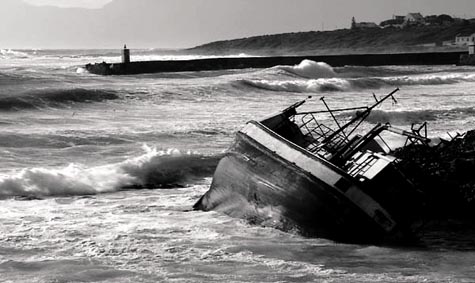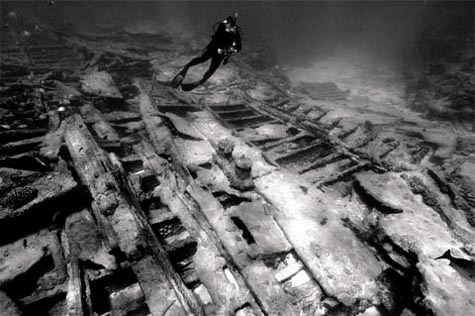 [Image: San Francisco, photographed in profile from Sausalito].
[Image: San Francisco, photographed in profile from Sausalito].In preparation for an overnight business trip to San Francisco this weekend, I was flipping through the Lonely Planet Guide to San Francisco – when I read something that is surely old news for anyone living in that city, but that nonetheless completely blew me away.
It turns out that part of San Francisco is actually built on the wrecked and scuttled remains of old ships.
 [Image: A shipwreck that has absolutely no connection to San Francisco].
[Image: A shipwreck that has absolutely no connection to San Francisco].The Lonely Planet guide writes that "most of this walk [through the streets near the Embarcadero] is over reclaimed land, some of it layered over the scores of sailing ships scuttled in the bay to provide landfill."
Stunned – and absolutely fascinated by this sort of thing – I determined to learn more.
And it's true: a good part of coastal San Francisco is not built on solid ground, but on the forgotten residue of buried ships.
In an image that makes me want to cry it's so cool, the basements of some 19th-century San Francisco homes weren't basements at all... they were the hulls of lost ships.
"As late as Jan 1857," we read, "old hulks still obstructed the harbor while others had been overtaken by the bayward march of the city front and formed basements or cellars to tenements built on their decks. Even now [1888] remains of the vessels are found under the filled foundations of houses."
In other words, when you walked downstairs to grab a jar of preserved fruit – you stepped into the remains of an old ship.
It's almost literally unbelievable.
 [Image: Another shipwreck – unrelated, as far as I'm aware, to San Francisco].
[Image: Another shipwreck – unrelated, as far as I'm aware, to San Francisco].Best of all, those ships are still down there – and they're still being discovered.
- In the late 1960s, as San Francisco was building its BART subway system, discoveries of ships and ship fragments occurred regularly. Over the following decades, ships and pieces of ships appeared during several major construction projects along the shore. As recently as 1994, construction workers digging a tunnel found a 200-foot-long (61-meter) ship 35 feet (11 meters) underground. Rather than attempt to remove the ship – which would have been both costly and dangerous – they simply tunneled right through it. When buried ships are found, they’re sometimes looted for bottles, coins, and other valuable antiques frequently found inside. Among the prizes found in the ships have been intact, sealed bottles of champagne and whiskey, nautical equipment, and a variety of personal effects from the passengers and crews.
Some random cable guy discovers it, digging down into someone's backyard to fix a transmission problem. His shovel cracks through the outer wooden shell of a 19th-century frigate, releasing a cloud of invisible bacteria... he inhales it... his brain begins to bleed... Eli Roth directs the film version.
But this also reminds me of the now classic film Quatermass and the Pit – a movie which genuinely needs to be remade, and I would gladly serve as a screenplay consultant – in which London Tube excavations uncover a buried spaceship... out of which emerge weird aliens intent on vanquishing the Queen's English. Or something like that.
But the question remains: do you really know what's beneath your house or apartment...?
An entire armada of lost fishing ships, now rotting in the mud, nameless and undiscovered, shivering with every earthquake.
No comments:
Post a Comment